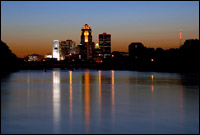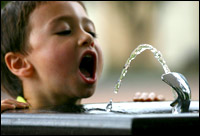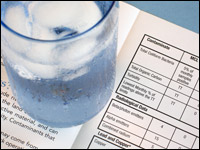Last month, “toxic gumbo” entered the American lexicon with the speed and force of the floodwaters it describes. A LexisNexis search of major U.S. publications doesn’t return a single hit for the phrase in the year before Hurricane Katrina. But in the 30 days after the storm’s landfall, 66 articles contained the phrase.

Measure twice, cup once.
“I want to be very clear,” cautioned EPA administrator Stephen Johnson, describing the situation in the devastated city to the press. “Emergency response personnel and the public should avoid direct contact with any floodwater.”
It was a dire warning. And to some water-quality experts, it came as no surprise. Our national water infrastructure — everything from streams, lakes, and coastal waters to treatment plants and the pipes that carry the precious liquid to our individual taps — is in serious trouble, they say. Toxic gumbos are simmering, for the most part out of sight, all across the country. New Orleans was just the first to boil over on a grand scale.
“When we hear about the floodwaters in New Orleans,” says Joan Rose, a water researcher at Michigan State University, “we need to think about what’s going on in our own backyards.”
To learn more, I decided to do just that.
My Rocky Raccoon
When a reporter for The Washington Post asked Johnson if anything in the New Orleans floodwaters made them different from past floods, the first thing Johnson mentioned was bacterial counts — levels of fecal E. coli so high he called the situation “unique.” (The only other contaminant Johnson named at the time was lead; analysts have found that the water contains, among other things, hexavalent chromium, arsenic, the petroleum derivatives benzene and toluene, and a pesticide that was one of the main ingredients in Agent Orange.)
The highest E. coli reading at that point had come from a sample retrieved on Sept. 8, 10 days into the flood. In 100 milliliters of water — less than half a cup — the EPA found 18,416 colonies of E. coli, a level 92 times greater than is considered safe for human contact. Most strains of E. coli are harmless, but its presence is a red flag to health officials, warning that potentially deadly pathogens such as dysentery and hepatitis may be in the water. One strain is itself toxic, and can cause symptoms ranging from abdominal cramping and diarrhea to kidney failure, paralysis, and, in rare cases, death.
That’s why Johnson gave his warning. And that perplexes L. D. McMullen.
McMullen knows something about water quality. He is general manager of the Des Moines Water Works, which supplies drinking water for more than 300,000 residents in Iowa’s capital city and suburbs — a position he’s held for two decades. McMullen also wrote his doctoral dissertation on water quality, and taught the subject at the University of Iowa before coming to the DMWW. And he’s the person I consult to find out how the waters of the Raccoon River, the backyard of my childhood, are faring.

Downtown Des Moines.
The part that has McMullen stumped is why Johnson spoke so dramatically about NOLA’s bacterial levels, when the Raccoon regularly has readings that are just as high or higher. According to DMWW records, the Raccoon — from which Des Moines draws most of its drinking water — had E. coli readings up to three times higher than NOLA’s toxic gumbo five times in 2005 alone. The river’s all-time high was set in 1996, the first year of regular monitoring, when a 100 mL sample contained 154,020 E. coli colonies — a whopping 770 times higher than the EPA’s national no-contact standard.
These levels occurred after rainstorms, but nothing like the hurricane and flood that struck New Orleans. Which begs the question: where is all that bacteria coming from?
“Livestock waste,” says Susan Heathcote, research director of the nonprofit Iowa Environmental Council. “Lots of livestock waste.”
Cattle and hogs are likely the primary source of the E. coli in the Hawkeye state, where livestock outnumber humans six to one. Based on U.S. Department of Agriculture data, Heathcote calculates that 225,000 head of cattle and nearly 2 million hogs are raised in the 3,600-square-mile Raccoon watershed. Day in and day out, these animals produce the same amount of excrement as the 8 million residents of New York City.
Last year, state officials investigating a fish kill in a small creek that empties into the Raccoon found readings of 14 million fecal coliform colonies per 100 mL sample. “Some of these tributaries at times can be little more than liquid manure,” reported a scientist familiar with the area. Investigators from the Iowa Department of Natural Resources ultimately concluded that manure from a nearby cattle feedlot killed the fish.
The Heartland recipe for toxic gumbo calls for a long list of other farm runoff too, including pesticides and herbicides. More than a billion pounds of nitrogen-rich fertilizer are applied to Iowa fields each year, and rain washes large amounts of it into tributaries. To keep its drinking water safe, the DMWW spent nearly $4 million in 1994 to build the world’s largest nitrate-removal system. Because the system costs $3,000 a day to operate, it is only used when nitrate levels approach the EPA’s “danger zone.” When it was first built, McMullen figured he’d only use the system 40 days a year; more often than not, however, he’s had to put it into service on more than 100.
Despite the Raccoon’s problems, McMullen maintains that not a single glass of water has left his facility containing even one colony of E. coli. “But the Raccoon often has the same E. coli as New Orleans, or more,” he says. “And no one’s warning people not to go in it.”
The Drip to Bountiful
There are two possible explanations for that lack of warnings. The toxic gumbo in New Orleans may not have been as dangerous as EPA’s Johnson claimed. Or, less optimistically, the 200-mile-long Raccoon River — which forms the centerpiece of many city, county, and state parks — is more dangerous than most people think.
Asked which interpretation is correct, McMullen hesitates before replying, “I’m thinking that it’s a dangerous level here.” Then he adds, “But I’m no health expert.”
Rose is, however. Rose holds the Homer Nowlin Chair for Water Research at Michigan State University, where she specializes in waterborne diseases. She confirms that the bacterial levels in the Raccoon are unsafe. “I was horrified by the readings in New Orleans,” she says. “But Iowans should be horrified about their water quality as well.”
And it’s not just Iowans who should be concerned, says Rose. Other states and cities have gumbos of their own.
In April 1993, more than 400,000 Milwaukee residents fell ill and more than 100 died when that city’s water system became contaminated with the parasite cryptosporidium, which penetrated filters in one of the city’s water-treatment plants. Researchers suggested runoff carrying animal waste, effluent from slaughterhouses, and human sewage as likely sources.
In 1997, perchlorate, a primary component of rocket fuel, was found in the lower Colorado River and traced back to a Kerr-McGee fuel manufacturing plant in Nevada. Downstream from the plant, the river irrigates California’s Imperial Valley, where most of the nation’s winter vegetable crops are grown. Since then, perchlorate has been found in drinking-water supplies in 34 states. A recent study published in Environmental Science & Technology found, after analyzing breast milk from 36 women in 18 states, that the average month-old baby consumes six micrograms of perchlorate each day — two times higher than the level considered “safe” by the EPA. (A level, it should be noted, that was raised after the primary users of perchlorate — the Department of Defense, the Department of Energy, and NASA — objected to a stricter standard.)

What a long, strange sip it’s been.
Last year, The Washington Post revealed that century-old pipes in the nation’s capital were leaching lead into the District’s drinking water at rates 10 times the legal limit. Water from a tap at one D.C. public school had lead levels 60 times higher than is considered safe. (Lead is particularly dangerous for children and developing fetuses, because it disrupts brain development.) The Post examined EPA data and found that 274 water utilities throughout America had delivered lead-contaminated water to some or all of their customers — a total of more than 11 million people — at least once since 2000.
For those who head to the beach to escape tainted city and rural waters, Nancy Stoner at the Natural Resources Defense Council has some bad news. “Good luck finding clean water there,” she says. “You may be in for an unpleasant surprise.” A report Stoner supervised, which was based largely on EPA data, found that in 2004, U.S. beaches closed or posted health advisories nearly 20,000 times — from Maine (56) to Florida (3,345), from Texas (834) to Washington (72). In most cases, says Stoner, the danger was from high levels of fecal coliform. Contaminated storm water and sewage, either untreated or partially treated), are generally to blame.
These episodes — E. coli at the beach, parasites in city water systems, rocket fuel in breast milk, heavy metals in pipes — are different aspects of one very large problem, according to Betsy Otto, senior advocacy director at the nonprofit American Rivers. “What we’re seeing is the slow collapse of America’s water infrastructure,” she says. “It’s a looming public health crisis.”
So Hose the Nation
Katrina and the toxic gumbo that “filled the bowl” of New Orleans focused the nation’s attention on water in one particular place at one moment in time. But Otto says that “these kinds of situations exist in many parts of the country. And usually we just ignore them.”
That may not be an option for much longer.
In a “report card” on the nation’s infrastructure released earlier this year, the American Society of Civil Engineers gave the country’s drinking-water system a D-. The report warned that water-treatment facilities and the vast networks of pipes that deliver water to our houses, schools, and businesses “are near the end of their useful life.”
A few years earlier, in 2002, the EPA had pointed to an $11 billion gap between what’s spent annually on water infrastructure and what’s needed to avert a crisis. If that gap and others aren’t closed, the EPA warned, “by 2016, pollution levels could be similar to levels observed in the mid-1970s.” Meanwhile, the Bush administration has consistently tried to cut federal loans to states for repairing or replacing outdated sewage-treatment plants. The annually appropriated Clean Water State Revolving Loan Fund is currently at just 66 percent of its 2001 level. The result: facilities continue to age, and the teetering system, like the levees around New Orleans, will break down more and more frequently, with larger and more dire consequences.
As for rivers and streams themselves, says Erik Olson, senior attorney with NRDC, the EPA has all but abandoned its mission to clean up and safeguard the nation’s waterways. “This issue isn’t even on their back burner,” he charges. “It’s way in the back of their kitchen cabinet.”
For most Americans, the fragile condition of the country’s water infrastructure remains similarly out of sight and out of mind. Even along the banks of the polluted Raccoon River, few recognize the enormity of the problem. I spoke to a friend in Des Moines recently who questioned whether the state’s waterways could really be in such bad shape. “You have to ask yourself,” she said, “if the water’s so dangerous, where are all the bodies?”
I pose her question to Rose, whom Water Technology magazine recently named one of the 21 most influential people in water in the 21st century. It turns out she gets asked this a lot.
“Actually, a lot of people do get sick” from polluted water, she says. And some die. But no one knows how many, because there is no national database for tracking waterborne illnesses. A 1996 amendment to the Safe Drinking Water Act instructed the EPA and Centers for Disease Control and Prevention to design and implement such a system, producing a national report on waterborne disease occurrence by 2001. But I asked EPA spokesperson Dale Kemery about the report, and he replied, “I am not aware that it has been released, and I would know.”
Based on her own research, Rose estimates that for every report of a waterborne illness, there are an additional nine “statistical ghosts” who don’t show up on the records.
“It is like walking through a graveyard with no markers, no headstones,” she says. “If you dug a little, you would find the dead bodies. Otherwise, you stand on the grassy mound and say, ‘Everything looks fine from here.'”

